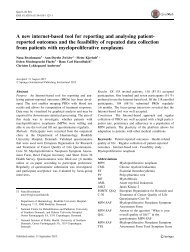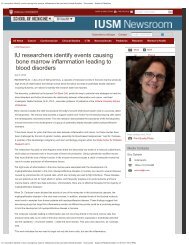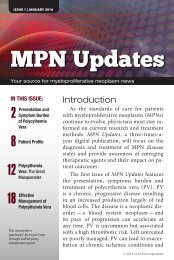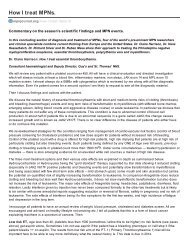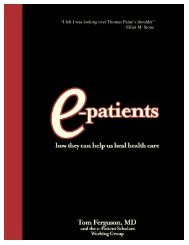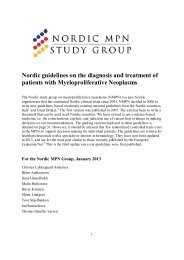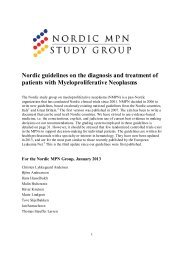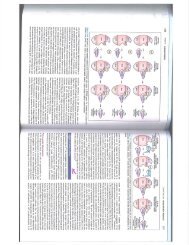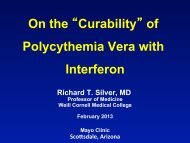Now what do you have to learn?
Create successful ePaper yourself
Turn your PDF publications into a flip-book with our unique Google optimized e-Paper software.
So – <strong>you</strong> <strong>have</strong> this thing<br />
<strong>Now</strong> <strong>what</strong> <strong>do</strong> <strong>you</strong> <strong>have</strong> <strong>to</strong> <strong>learn</strong>?<br />
Susan J. Leclair, Ph.D, CLS(NCA)<br />
Chancellor Professor<br />
Department of Medical Labora<strong>to</strong>ry Science<br />
University of Massachusetts<br />
Dartmouth Massachusetts USA
Once upon a time,"<br />
Physicians knew all the answers and patients believed them<br />
Not so much anymore<br />
Used <strong>to</strong> be <strong>Now</strong> a Days<br />
Get a diagnosis Get a diagnosis<br />
Cry Cry<br />
Go <strong>to</strong> church, temple, etc. Go online & search<br />
Take the meds Go for the roots & berries<br />
Do <strong>what</strong> the physician says Argue – ask “why”
Physicians speak in medicalese and only rarely<br />
in English<br />
So<br />
You <strong>have</strong> <strong>to</strong> <strong>learn</strong> medicalese.
It takes two <strong>to</strong><br />
miscommunicate<br />
Patient Words Translation<br />
fine I <strong>do</strong>n’t want this <strong>to</strong> be bad so <strong>you</strong> won’t<br />
mind if I skip a few salient details.<br />
not bad It really hurts like hell but I’m supposed<br />
<strong>to</strong> be brave (male)<br />
It really hurts but I know no one pays<br />
attention <strong>to</strong> my complaining about pain<br />
so why tell (female)<br />
I didn’t tell him You’re the hot shot; go figure it out without<br />
because he didn’t ask telling <strong>you</strong>
It takes two <strong>to</strong><br />
miscommunicate<br />
Physician Words Translations<br />
fine It is not a surprise <strong>to</strong> me so I<br />
<strong>do</strong>n’t <strong>have</strong> <strong>to</strong> explain why <strong>to</strong><br />
<strong>you</strong>.<br />
Let’s repeat it in I am not sure why this is here<br />
few weeks so let’s hope it goes away<br />
That is my job I can’t explain this in English
What is Jak-Stat?<br />
Original name – just another kinase<br />
Some translations<br />
The Janus kinase-signal transducer and activa<strong>to</strong>r of<br />
transcription (JAK-STAT) pathway mediates signaling by<br />
cy<strong>to</strong>kines, which control survival, proliferation and<br />
differentiation of several cell types.<br />
Constitutive JAK activation leads <strong>to</strong> persistent<br />
activation of STAT transcription fac<strong>to</strong>rs.
WHAT????????
How <strong>do</strong>es this sound:<br />
JAK2 is a gene that turns on a series of actions that<br />
controls the production of blood cells and fibrocytes<br />
When abnormal, control is lost and excessive numbers of<br />
cells are produced
The ball is in <strong>you</strong>r<br />
court<br />
Under normal physiological circumstances when a ligand<br />
(for example - EPO) binds with a recep<strong>to</strong>r, a<br />
conformational changes occurs. The JAK2 protein<br />
then makes contact with the cy<strong>to</strong>plasm <strong>do</strong>main of the<br />
recep<strong>to</strong>r where it catalyzes tyrosine phosphorylation.<br />
This leads <strong>to</strong> the activation of signal transducers and<br />
transcription (STAT) molecules<br />
????????
OR<br />
Erythropoietin chemically binds <strong>to</strong> a recep<strong>to</strong>r controlled by JAK2. When<br />
the two are bound <strong>to</strong>gether, the cell becomes committed <strong>to</strong> making red<br />
blood cells.<br />
If less erythropoietin, fewer cells should be made.<br />
BUT – with the JAK2 (V617F) mutation, the STAT enzymes are always<br />
on, causing more cells <strong>to</strong> be made regardless of the amount of EPO.<br />
Over time, the mutation will cause damage <strong>to</strong> the platelets,<br />
granulocytes, and fibrocytes
One more language<br />
issue<br />
The US will not go along with the<br />
international system of concentration and<br />
values so<br />
US really old 5,000 cells or 5K/cumm<br />
US medium old 5.0x10 3 /µL or<br />
Rest of world 5.0x10 6 /L
My spreadsheet (or "<br />
my “precious”)<br />
WBC – <strong>to</strong>tal number of white blood cells<br />
- can bounce around within a +/- 3.0 range<br />
- can <strong>do</strong>uble the neutrophils/granulocytes if fever,<br />
exercise, emotional stress, etc. are present<br />
- suppressed by lots of cardiac meds such as ACE<br />
inhibi<strong>to</strong>rs (ex. Lisinopril) so <strong>do</strong>n’t every let anyone<br />
say <strong>to</strong> <strong>you</strong> that things cannot be connected.
WBC<br />
As MPN’s progress, the white cell count will wander<br />
erratically higher.<br />
Clinical significance is hard <strong>to</strong> define since it can<br />
bounce so easily.<br />
If out of the reference interval –greater than<br />
3.0x10 3 /L is worthy of note
WBC Differential<br />
Two different ways <strong>to</strong> describe the different white blood cells <strong>you</strong> see<br />
a. percentage<br />
older form of differential<br />
identify the first 100 cells <strong>you</strong> see<br />
makes great comments about quality<br />
both an increase in one cell or a decrease in another<br />
cell line can look the same<br />
b. absolute<br />
identifies between 10,000-50,000 cells<br />
variable on quality but superb on quantity
WBC<br />
Follow the granulocytes/neutrophils for they are controlled by the<br />
same cell (common myeloid progeni<strong>to</strong>r cell) as the red cells<br />
No immature forms should be seen although a once in a while an<br />
intermediate form (metamyelocyte) can be <strong>to</strong>lerated
Date WBC ANC<br />
Ref. interval Ref. interval<br />
Value Value
Hemoglobin<br />
You can count RBCs but no one takes that value seriously any more.<br />
There are better tests.<br />
Hemoglobin – concentration of oxygen carrying protein<br />
- can quantify the hemoglobin that has oxygen and<br />
the hemoglobins that <strong>do</strong> not (carboxyhemoglobin)<br />
or can not (carboxyhemoglobin)<br />
remains consistent regardless of cell size
Hemoglobin<br />
Hemoglobin – varies by gender, age and altitude<br />
Signs and symp<strong>to</strong>ms of anemia<br />
- Around 10.0 g/ml (or 100 g/L in Canada)<br />
- pallor, shortness of breath, fatigue, etc<br />
Below 8g/dL or 80g/L( Canadian)<br />
- damages organs due <strong>to</strong> lack of O 2<br />
- usually need transfusions
Hemoglobin<br />
Hemoglobin – issues in over production<br />
More cells make the blood more viscous (jello with a lot of fruit as<br />
opposed <strong>to</strong> clear jello<br />
Over 15g in males and 14 g. in women<br />
a. increased blood pressure – kidney damage and/or CVAs<br />
b. increased cardiac stress – heart attack<br />
c. increased fragility in blood vessels<br />
d. best indica<strong>to</strong>r of phlebo<strong>to</strong>my need
Hema<strong>to</strong>crit (HCT)<br />
Hema<strong>to</strong>crit"<br />
once upon a time – most accurate test in<br />
the clinical labora<strong>to</strong>ry<br />
now –we <strong>do</strong>n’t perform it. We calculate it so<br />
not as accurate or reliable
Hema<strong>to</strong>crit"<br />
Hema<strong>to</strong>crit is calculated from the MCV (average<br />
Red cell size)<br />
calculated<br />
If <strong>you</strong> know the average size of the cells,<br />
then <strong>you</strong> simply multiply the MCV by the RBC<br />
count and <strong>you</strong> get the hema<strong>to</strong>crit.
Hema<strong>to</strong>crit<br />
Hema<strong>to</strong>crit"<br />
only makes sense if all the cells are the<br />
same size but as the RDW increases and<br />
the MCV decreases, it gets fuzzier.<br />
When the RDW is greater than 20, the hema<strong>to</strong>crit is invalid so<br />
using the hemoglobin values is most consistent.
How <strong>do</strong> <strong>you</strong> decrease viscosity?<br />
1. lower the RBC absolute number<br />
easiest method – phlebo<strong>to</strong>my<br />
2. make them smaller<br />
make them iron deficient<br />
Hemoglobin
But wait (as the TV ads say)<br />
Hemoglobin<br />
if <strong>you</strong> phlebo<strong>to</strong>mize someone, <strong>you</strong> make them iron<br />
deficient so, for a short time only, <strong>you</strong> can get damaged<br />
cells that are smaller and will not live as long AND <strong>you</strong><br />
get an increase in smaller platelets!
Should look like this<br />
Your own spreadsheet<br />
DATE WBC ANC HGB MCV MCH RDW PLT<br />
Ref.<br />
interval<br />
Ref.<br />
interval<br />
Ref.<br />
interval<br />
Ref.<br />
interval<br />
Ref.<br />
interval<br />
Ref.<br />
interval<br />
Ref.<br />
interval<br />
Value Value Value Value Value Value Value<br />
Hemoglobin values will be lower in the evening<br />
(as much as 1 g/mL) probably due <strong>to</strong> changing<br />
levels of hydration, so try <strong>to</strong> <strong>have</strong> the blood<br />
specimen collection at the same time each time.
Chemistry values<br />
IF <strong>you</strong> <strong>have</strong> time<br />
Uric acid – waste product of nuclear metabolism<br />
The more cell activity, the greater the number of waste<br />
products that must be cleared by the kidney<br />
Too much – gout, kidney damage, joint pain<br />
Keep <strong>you</strong>r diet consistent – high protein meals increase<br />
uric acid concentration
Chemistry<br />
LD (lactate dehydrogenase)– almost every<br />
cell in the body has this enzyme. When the<br />
cell is damaged/dies, the enzyme is released<br />
in<strong>to</strong> the blood stream<br />
Increases in this suggest increased damage but <strong>you</strong><br />
can’t use this when on meds.
SO<br />
WBC ALC ANC HGB MCV RDW PLT Uric<br />
Acid<br />
Ref.<br />
interval<br />
Ref.<br />
interval<br />
Ref.<br />
interval<br />
Ref.<br />
interval<br />
Ref.<br />
interval<br />
Ref.<br />
interval<br />
Ref.<br />
interval<br />
Ref.<br />
interval<br />
LD<br />
(LDH)<br />
Ref.<br />
interval<br />
Variation Variation Variation Variation Variation Variation variation Variation variation
Liver function studies<br />
LD, bilirubin, alkaline phosphatase, ALT, GGT<br />
bilirubin – either liver damage or hemolysis<br />
alkaline phosphatase – bone, GI tract, liver damage<br />
ALT – enzyme found only in liver cells<br />
GGT – another enzyme from the liver but 1<br />
aspirin can cause it <strong>to</strong> increase
Probably not<br />
If hemolysis - reticulocyte count<br />
Is that all??????<br />
If loss of immune function proteins esp.<br />
immunoglobulins<br />
serum protein electrophoresis<br />
or immunoelectrophoresis
For the anal-retentive<br />
That is anal retentive<br />
WITH<br />
the hyphen<br />
WBC ALC ANC HGB MCV RDW PLT Uric<br />
Acid<br />
Ref.<br />
interval<br />
Ref.<br />
interval<br />
Ref.<br />
interval<br />
Ref.<br />
interval<br />
Ref.<br />
interval<br />
Ref.<br />
interval<br />
Ref.<br />
interval<br />
Ref.<br />
interval<br />
LD<br />
(LDH)<br />
Ref.<br />
interval<br />
Retic<br />
count<br />
Ref.<br />
interval<br />
Bilirubin Protein Just in<br />
case<br />
Ref.<br />
interval<br />
Ref.<br />
Interval<br />
variation variation variation variation variation variation variation variation variation variation variation variation variation



